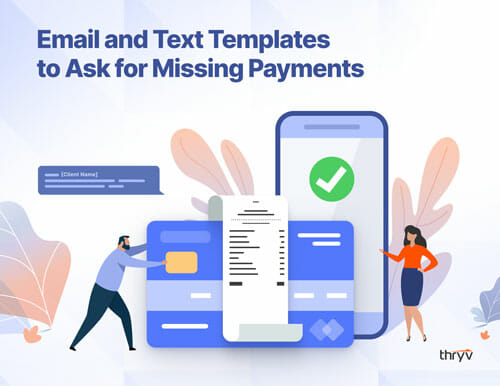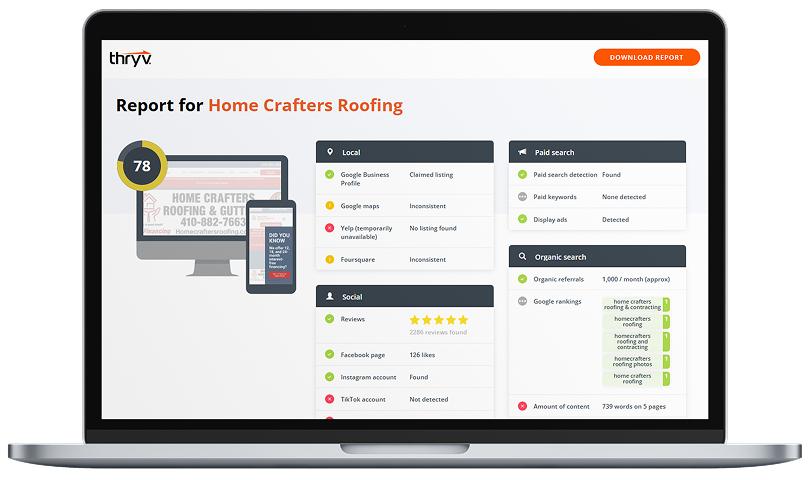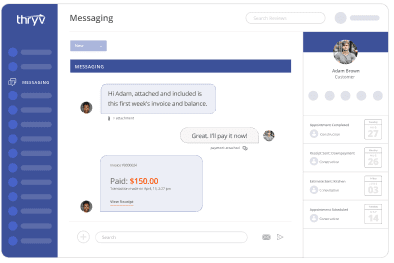Email marketing is one of the most effective ways to maintain a strong connection with your customers. But before you can send out those beautifully crafted newsletters and promotions, you need one crucial thing: email addresses.

Free Guide: Email and Text Templates to Ask for Missing Payments
Use these free email and text templates to cut down on missed and late payments from your customers.
Download Now
Whether you’re just getting started or looking to grow your list, collecting emails the right way is key to building a strong, engaged audience that actually wants to hear from you. In this post, we’ll walk you through simple, innovative, and ethical ways to collect emails for email marketing and help direct people to your website.
How to Collect Data for Email Marketing
- Incentivize your email list.
- Make it easy to sign up.
- Focus on retention.
- Use social media to promote sign-ups.
- Create a landing page just for email sign-ups.
- Offer exclusive discounts or early access.
- Collect emails in person.
- Add a sign-up prompt to your blog or resources.
- Use exit-intent pop-ups.
- Run a contest or giveaway.
- Add a sign-up option at checkout.
1. Incentivize your email list.
People are more likely to share their email addresses with you if they get something in return — and that’s where lead magnets come in. A lead magnet is an incentive you offer in exchange for someone’s email. It could be a free downloadable guide, a helpful checklist, a set of templates, access to a short workshop, or a resource you know your audience will find valuable. The key is to offer something relevant and genuinely helpful that solves a small problem or adds immediate value.
Once someone signs up and receives your freebie, you’ve created a natural entry point into your business. From there, your emails can introduce your products or services, build trust, and guide them toward becoming customers. It’s a win-win: your subscribers receive something helpful, and you can establish a meaningful relationship, one email at a time.
2. Make it easy to sign up.
Even the best lead magnet won’t help if your email sign-up process is clunky or confusing. That’s why it’s important to make joining your list as simple and seamless as possible. Place your sign-up form in a prominent location, such as your website’s homepage, blog posts, or footer. Ensure it’s mobile-friendly, allowing users to subscribe from any device. Keep the form concise; asking for just a first name and email is usually enough to get started.
You can also use pop-ups, slide-ins, or banners to catch attention but use them sparingly. A well-timed pop-up is effective, while one that appears every five seconds might drive people away.
The goal is to make subscribing feel like a no-brainer, not a chore. By reducing friction and making the sign-up process quick and easy, you’ll increase your chances of turning curious visitors into loyal subscribers.
3. Focus on retention.
Getting someone to sign up for your email list is just the beginning — keeping them engaged is where the real magic happens. One of the most effective ways to boost email retention is to send consistent, high-quality content. Whether you’re sending weekly, bi-weekly, or monthly updates, the key is to stick to a schedule so your audience knows what to expect. A content calendar can be a lifesaver here, helping you plan and stay organized without scrambling at the last minute.
You’ll also want to ensure your emails resonate with your readers — and that’s where A/B testing comes in. By testing elements such as subject lines, email copy, visuals, and call-to-action buttons, you can determine what works best and refine your approach.
For example, try experimenting with subject line length, tone, or personalization to improve open rates. Or test different CTAs and button styles to see which ones drive more clicks. These minor tweaks can lead to significant improvements over time, keeping your audience engaged and less likely to click the unsubscribe button.
4. Use social media to promote sign-ups.
Your social media audience already follows you because they’re interested in what you do, so why not take that connection a step further by inviting them to join your email list? It’s a natural next step and a great way to stay top of mind.
One of the easiest ways to start is by sharing your lead magnet (like a free guide, discount, or exclusive resource) directly in your posts. Provide a brief preview of the value they’ll receive and clearly indicate that subscribing is the way to access it.
You can drop your sign-up link in your bio and regularly reference it in captions, Stories, or pinned posts. On platforms like Instagram and TikTok, Stories or Reels are a great place to chat casually about what your newsletter includes, why it’s worth signing up for, and what subscribers can expect. If you’re on LinkedIn, create a post or article that breaks down the benefits of your email content, especially if you’re targeting professionals or B2B audiences.
If you’re running paid ads, use them to drive traffic to a clean, focused landing page built just for email sign-ups. Ensure the page clearly highlights what your audience will gain from joining; simply stating “subscribe to our newsletter” is no longer sufficient. Show them the value, and they’ll be much more likely to click that subscribe button.
5. Create a landing page just for email sign-ups.
Instead of simply tucking your email sign-up form into a corner of your homepage, consider creating a dedicated landing page highlighting why someone should join your list. This provides more space to explain the benefits, such as receiving exclusive content, special discounts, or early access to new products. A landing page lets you speak directly to your ideal subscriber without distractions.
If you’re offering a lead magnet, such as a freebie or a limited-time discount, a landing page is the perfect place to showcase it. Keep the design clean and focused, with a clear headline, a concise explanation of what users will receive, and an easy-to-complete sign-up form. The goal is to make it as appealing and straightforward as possible for someone to hand over their email; a well-crafted landing page can do just that.
6. Offer exclusive discounts or early access.
Everyone loves a good deal; using that to your advantage is a smart way to grow your email list. Offering a one-time discount, a free shipping code, or early access to a new product or service can be the nudge someone needs to subscribe. This provides potential customers with added value from the outset, helping establish trust and interest in your offer.
To maximize the effectiveness of this strategy, ensure that the offer is exclusively available to email subscribers. This gives people a reason to sign up and creates a sense of exclusivity as if they’re gaining access to something special. Be sure to follow through with a well-crafted welcome email that delivers the promised perk and introduces them to your brand in a friendly and helpful way.
7. Collect emails in person.
You can collect emails face-to-face if you attend trade shows, local markets, networking events, or run a brick-and-mortar shop. These in-person moments are great for building trust and creating genuine connections, so don’t be shy about inviting people to join your list while chatting with them.
You can set up a tablet with a simple digital sign-up form, place a paper form near the register, or even include a short sign-up prompt on your receipts.
Another effective approach is to ask customers directly at checkout or after a positive interaction. Just ensure they’re opting in willingly and understand what they’re signing up for. You can sweeten the deal with a small incentive, such as a discount on their next purchase or a gift with their sign-up. Since the interaction is in person, it feels more personal and less “salesy,” which makes people more likely to say yes.
8. Add a sign-up prompt to your blog or resources.
If you publish blog posts, downloadable resources, or helpful content on your website, don’t miss the chance to invite readers to join your email list. A simple, well-placed call-to-action (CTA) at the end of a post — or even sprinkled throughout longer content — can make a big difference. You’ve already captured their attention with something valuable, so it’s the perfect time to offer more through your emails.
This strategy works exceptionally well when your email content naturally builds on what they’ve just read. For example, if your blog post shares five tips, let readers know you can deliver five more directly to their inbox. Or, if your post offers a free resource, ask for their email in exchange for the download. People are more likely to subscribe when the CTA feels like a helpful next step rather than a hard sell.
9. Use exit-intent pop-ups.
Exit-intent pop-ups can capture potential subscribers just before they leave your website. These pop-ups appear when a visitor is about to navigate away from your page, often triggered by their mouse movement toward the browser’s back or close button.
This makes it the perfect moment to offer a last-minute incentive, such as a lead magnet, discount, or exclusive offer, right before they bounce. Since exit-intent pop-ups only show up when the visitor is actively leaving, they tend to be less intrusive than traditional pop-ups that interrupt the browsing experience mid-session. The key is making the offer relevant, clear, and easy to accept, ensuring visitors share their email before they go.
10. Run a contest or giveaway.
Hosting a giveaway is a fun and engaging way to grow your email list while offering something valuable to your audience. By making their email a requirement for entry, you create an easy, low-barrier way for people to subscribe and participate.
However, the success of your giveaway depends mainly on the prize you offer. Selecting something that aligns with your business and genuinely appeals to your target audience is essential. A prize that reflects the interests and needs of your ideal customer will help attract high-quality leads who are more likely to be interested in your products or services than just people looking for free stuff.
For example, if you run a fitness brand, offering a giveaway for a high-quality gym bag, workout gear, or a free consultation could be much more effective than giving away generic items. When the prize directly aligns with your audience’s desires, it encourages people genuinely interested in your niche to enter, making them more likely to engage with your emails and marketing efforts.
Promote your giveaway across your website, social media, and email channels, and keep the entry process simple to maximize sign-ups. To maintain transparency and professionalism, communicate when and how the winner will be chosen and any relevant terms and conditions.
11. Add a sign-up option at checkout.
If you sell products or services online, a simple yet highly effective way to collect email addresses is to add an opt-in checkbox during checkout. Since your customers are already engaged with your brand and interested in what you offer, this presents a seamless, low-effort opportunity to stay connected after their purchase. By placing the checkbox in a non-intrusive spot (such as below their payment information), you allow customers to subscribe to your email list without feeling pressured.
This approach works well because it taps into the moment customers are already invested in your brand. They’ll appreciate staying informed about future promotions, product updates, or exclusive offers that you send via email. Additionally, it ensures you’re reaching people who have already shown an interest in your business, making your emails more welcoming and engaging. Just be sure the checkbox is unchecked by default to comply with best practices and privacy regulations, allowing customers to make an informed decision about joining your list.
Elevate Your Communication
Collecting emails for marketing campaigns is crucial to building strong, lasting relationships with your audience. By using a mix of strategies — whether it’s offering valuable incentives like lead magnets, making sign-up easy and accessible, or staying consistent with your content — you can grow your list with quality subscribers who genuinely want to hear from you.
Remember, the key is to focus on providing value and creating meaningful experiences for your subscribers right from the start. With these strategies in place, you’ll be well on your way to building an engaged and loyal email list that supports your business goals and drives long-term success.

Email and Text Templates to Ask for Missing Payments
Use these free email and text templates to cut down on missed and late payments from your customers.


